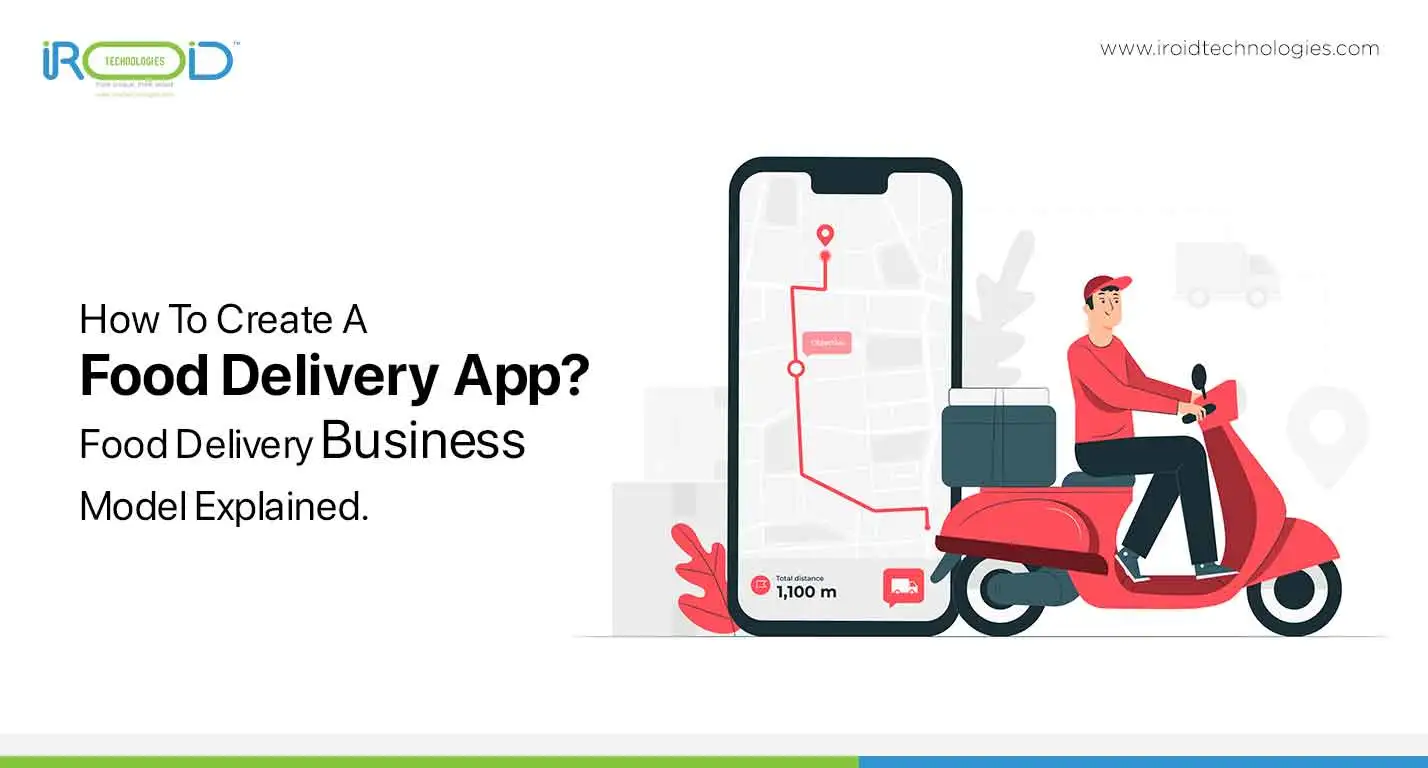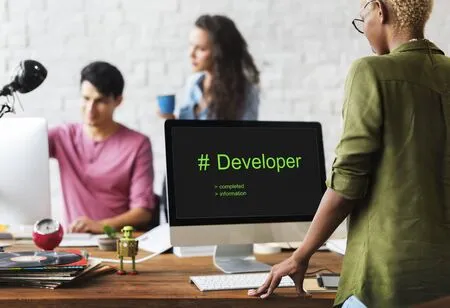How To Create A Food Delivery App? Food Delivery Business Model Explained

The weekend is here. The night before, you had a couple of too many drinks. And awakened at 2 p.m., starving for a nice pizza. You pull out your phone and utilize one of your several apps to place an order. Your doorbell rings after 20 minutes, and a man with a way too big company-themed blazer and cap gives you your meal. Sounds nice, isn’t it?
Food delivery has become an indispensable aspect of our daily lives. One-third of all Indians report ordering food online at least twice a week. The global market for online meal delivery is expected to reach $137 billion by 2023.
In this post, we'll take a deep look at meal delivery as a business concept. What caused that to happen? What are the advantages and disadvantages? In such a competitive market, how do you define success? These are just a few of the many questions we'll try to address before you hire app developers in India.
Also Read: Why should you hire mobile app developers in India from iROID?
Definition
Food delivery is a courier service in which food is delivered to consumers on demand by retailers, restaurants, or third-party applications. Orders are now processed through mobile applications, websites, or over the phone.
Deliveries include both prepared meals and goods from stores. Catering and wholesale are two more means of food distribution.
The earliest reported occurrence of food delivery dates back to 1889 in Italy. Raffaele Esposito, the inventor of the Pizza Margherita, was summoned by King Umberto and Queen Margherita to bring a pizza to their palace in Naples.
Economic need drove the modern-day meal delivery system's emergence. During the 1950s, the burgeoning American middle class was cooped up at home, watching television all day. This nearly brought the American restaurant business to its knees, forcing them to adapt by inventing the modern-day delivery systems we all know. According to reports from the time, this adaptation increase restaurant sales by more than 50% in a short period of time.
Also Read: Effective ways For Best App Ideas To Enhance Your Business.
How to make a food delivery application: 5 steps to follow
You need more than just cloning UberEats' features to create apps like it and gain customer popularity. We advise using the following techniques to assist you in outperforming similar and popular food delivery apps:
Step 1: Track Industry Trends for Food Delivery
The new delivery techniques and other tendencies must be evaluated:
Assume adding credentials for ordering via social media accounts to assist your project stand out in the selected niche. Domino's Pizza was the first business to employ this method of ordering, allowing customers to place orders using their Twitter accounts. To make an order, app users "tweeted" a pizza emoji to Domino's Pizza's Twitter account.
Step 2: Select a food delivery method
You must now decide business strategies for food delivery that best suits you.
Step 3: Conduct market research
You need to understand your target market if you want to create a great food delivery service. It is simple to create an app that perfectly satisfies the needs of the target consumers once you have an understanding of who will use the food delivery service.
The target market may be specific, like raw gluten-free vegans, or general, like pizza aficionados.
- Social traits such as age, gender, nationality, and income
- What possible client issue might your project address?
- What emotions will users of your application experience?
- Why should users choose this platform over rivals?
You will have a clear understanding of the target market once you have clarified each of these issues.
Step 4: Decide on the key components of food delivery services that resemble UberEats.
The following aspects should be taken into account while creating a smartphone app like Uber for food delivery:
The app's login feature enables the use of an email address or social network identity.
Search offers meal, filter, and food category options. Pictures of the dishes, a description of the preparation, and the menu should all be included in this part.
Meals can be counted to the cart.
The order total is shown at the order checkout along with all dishes chosen.
Users have the option of paying for their orders via the built-in payment gateway. Our recommendation is to incorporate a number of payment processors, including PayPal, Stripe, and MangoPay. This approach was used in the creation of a personalized marketplace.
Users are notified via push notifications and SMS about the order status.
Order tracking uses the Google Location API for Android apps and the CoreLocation framework for iOS apps to display real-time order tracking. Additionally, Google Maps and Mapkits will assist couriers in determining the best path to the customer's location.
Users of the app can rank and review restaurants through user reviews.
Step 5: Decide on the technology stack for developing food delivery apps.
You can require different technology for a food delivery firm depending on the business plan. However, we have compiled a necessary tech stack for apps similar to Uber in the chart below:
Restaurant listing
- Grubhub API
- FourSquare API
Payment gateway
- Square API
- Braintree
- Stripe
- PayPal
Find user location
- Core Location Framework
- Google Places API
- Google Maps
Push notifications
- Amazon SNS
- Urban Airship
- Firebase Cloud Messaging
Food Delivery Business Model Examples
Food delivery services come in many different forms and sizes. They range from systems that work with restaurants and drivers to an all-in-house strategy.
Platform-to-Consumer Business Model
Third-party apps under the Platform To Consumer Model show available eateries close to the customer's location, typically via a website or a mobile app.
Customers may then order from these partner restaurants and have their meals delivered by either the restaurant or a platform driver. Popular examples are Zomato, UberEats, and Swiggy.
Typically, the platform deducts 20 to 30 percent of the order value in addition to any potential shipping costs.
The Platform To Consumer approach is now the most popular manner of food delivery. It accounts for 63 percent of the $122 billion in sales generated each year.
Aggregators of Delivery Services
Although they technically come within the Platform to Consumer umbrella, they need independent notice. The platform operates as an intermediary between a client and a number of local eateries in the aggregator model. Furthermore, they provide customer service on behalf of these businesses in the event of delivery or order issues.
Every successful transaction handled by the platform is charged a set or variable fee. Some companies have lately tested various subscription models in which customers pay a monthly charge in exchange for free delivery and other savings.
Full-Stack Design
The food delivery company performs everything in-house under the Full-Stack Model. This requires not just developing the software and recruiting drivers but also preparing the meals.
Food is frequently cooked in so-called ghost or cloud kitchens. People cannot eat at these establishments since their primary function is to prepare meals for delivery. These cloud kitchens frequently enable the manufacturing of meals to be located in less expensive places while just renting out cooking space.
One of the key disadvantages of this concept is that significant investments are necessary to start the platform. Full-stack food delivery platforms, on the other hand, tend to profit more if an adequate scale is attained since they control the whole value chain. They can also better regulate the quality of their cuisine because everything is cooked in-house.
Other Related Post: The Modern Rules Of How To Create An App [Step-by-Step Guide].
Pros and Cons of the Food Delivery Business Model
While food delivery apps are difficult to develop and much more difficult to implement, they have enormous promise.
Food delivery firms have garnered a total of $15 billion in over 800 rounds of venture capital financing, according to Crunchbase. Many of these went on to become indispensable components of our everyday lives.
With that in mind, let's take a look at some of the advantages and disadvantages of running a meal delivery service.
An interesting previous post: How To Create A Successful On-Demand Delivery Mobile App In 2021?
Advantages
The stickiness of the product. Customers seldom move to a different app once they have been acquainted with a platform. According to McKinsey research, 77 percent of clients seldom transfer platforms. However, the higher the level of competition in a country, the more likely customers are to test out new offerings.
There are network effects. Because product delivery platforms are, in a broader sense, marketplaces that link buyers and providers, if an appropriate size is reached, they profit from the network effect. While networks are difficult to establish, they are even more difficult to reproduce. This has significant rewards for individuals who are able to create a large enough firm.
Prioritization of supply. As a food marketplace, your company may choose which restaurants and suppliers to advertise. This helps you to promote goods with larger margins and positive customer feedback.
Monopolistic pricing. In addition to prioritizing supply, food delivery companies can establish their own rates and commissions after they reach a certain level of size. There are several examples of quasi-monopolies raising costs immediately after purchasing their final rivals. Restaurants have little choice but to comply with any change because they rely on those applications to get orders.
There is no legal obligation to drivers. While unethical, drivers are often not hired by food delivery companies, but rather work on a contract basis. This significantly reduces operational costs because they are only paid when projects are completed. There is no necessity to provide medical insurance or provide for paid leave.
Helpful Post: Why should you hire mobile app developers in India?
Disadvantages
High running expenses. DoorDash allegedly lost $400 million in 2019, while Postmates was forced to lay off hundreds of staff and close certain locations. These are only two instances of food delivery companies that had to pay the price for their high operational costs and narrow profit margins. Companies that employ the full-stack strategy suffer from this, particularly when everything is kept in-house.
Operational complication. Developing the app, locating eligible restaurants and drivers, outfitting them with essential equipment, and optimizing delivery routes are just a few of the numerous issues that meal delivery services must address. Perfectly running such a firm is not only tremendously expensive but also a highly complicated undertaking with many moving components.
Tough competition. There are 572 meal delivery firms in the United States alone. With venture capital financing at an all-time high, starting a business has never been easier. Furthermore, they compete with other restaurants as well as customers' propensity to cook at home.
See this: 7 Things To Verify Before Hiring App Development Companies
Final Thoughts
It's safe to assume that the business model you pick has a huge impact on business growth because it dictates the path of operations for a company. As a result, selecting the best meal delivery business plan for your firm is critical. Before settling on a business model and a meal delivery service, you must examine variables such as client convenience, alignment with your business goals, and the extent of technical improvements.
As technology disrupts the online food delivery sector, we propose that you use a technology-enabled food delivery solution that enables you to satisfy clients' specific requests and evolving tastes.
For one of the best online meal delivery services available, built on an integrated model with incredible features and functions. If you want to construct an on-demand food delivery app with flexible delivery choices, we recommend to hire app developers in India.

